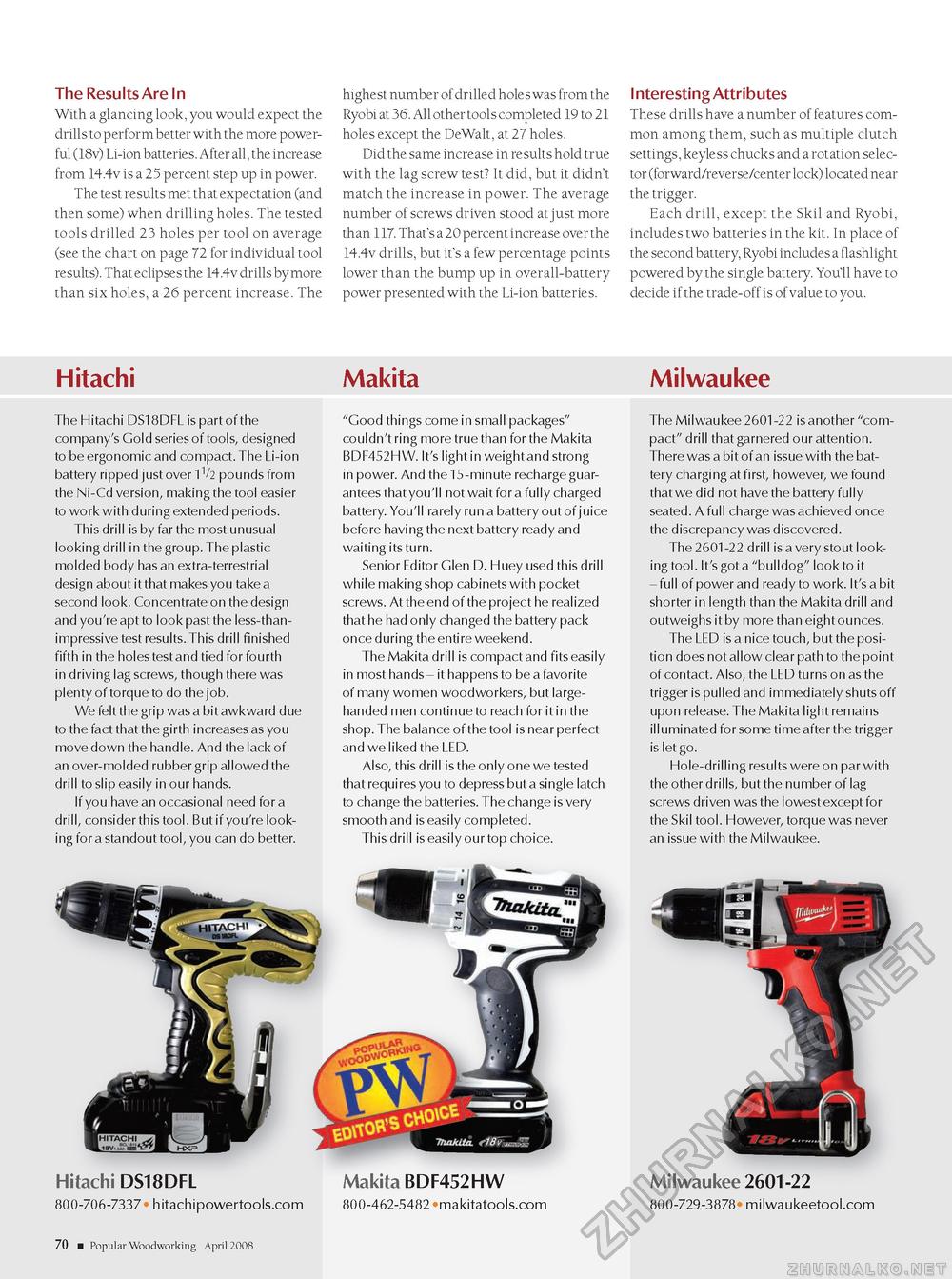Popular Woodworking 2008-04 № 168, страница 80
The Results Are In With a glancing look, you would expect the drills to perform better with the more powerful (18v) Li-ion batteries. After all, the increase from 14.4v is a 25 percent step up in power. The test results met that expectation (and then some) when drilling holes. The tested tools drilled 23 holes per tool on average (see the chart on page 72 for individual tool results). That eclipses the 14.4v drills by more than six holes, a 26 percent increase. The highest number of drilled holes was from the Ryobi at 36. All other tools completed 19 to 21 holes except the DeWalt, at 27 holes. Did the same increase in results hold true with the lag screw test? It did, but it didn't match the increase in power. The average number of screws driven stood at just more than 117. That's a 20 percent increase over the 14.4v drills, but it's a few percentage points lower than the bump up in overall-battery power presented with the Li-ion batteries. i nteresting Attributes These drills have a number of features common among them, such as multiple clutch settings, keyless chucks and a rotation selector (forward/reverse/center lock) located near the trigger. Each drill, except the Skil and Ryobi, includes two batteries in the kit. In place of the second battery, Ryobi includes a flashlight powered by the single battery. You'll have to decide if the trade-off is of value to you. Hitachi Makita Milwaukee The Hitachi DS18DFL is part of the company's Gold series of tools, designed to be ergonomic and compact. the Li-ion battery ripped just over 1V2 pounds from the Ni-Cd version, making the tool easier to work with during extended periods. This drill is by far the most unusual looking drill in the group. The plastic molded body has an extra-terrestrial design about it that makes you take a second look. Concentrate on the design and you're apt to look past the less-than-impressive test results. This drill finished fifth in the holes test and tied for fourth in driving lag screws, though there was plenty of torque to do the job. We felt the grip was a bit awkward due to the fact that the girth increases as you move down the handle. And the lack of an over-molded rubber grip allowed the drill to slip easily in our hands. if you have an occasional need for a drill, consider this tool. But if you're looking for a standout tool, you can do better. "Good things come in small packages" couldn't ring more true than for the Makita BDF452HW. it's light in weight and strong in power. And the 15-minute recharge guarantees that you'll not wait for a fully charged battery. You'll rarely run a battery out of juice before having the next battery ready and waiting its turn. Senior Editor Glen D. Huey used this drill while making shop cabinets with pocket screws. At the end of the project he realized that he had only changed the battery pack once during the entire weekend. The Makita drill is compact and fits easily in most hands - it happens to be a favorite of many women woodworkers, but large-handed men continue to reach for it in the shop. The balance of the tool is near perfect and we liked the LED. Also, this drill is the only one we tested that requires you to depress but a single latch to change the batteries. The change is very smooth and is easily completed. This drill is easily our top choice. The Milwaukee 2601-22 is another "compact" drill that garnered our attention. There was a bit of an issue with the battery charging at first, however, we found that we did not have the battery fully seated. A full charge was achieved once the d iscrepancy was d iscovered. The 2601-22 drill is a very stout looking tool. it's got a "bulldog" look to it - full of power and ready to work. it's a bit shorter in length than the Makita drill and outweighs it by more than eight ounces. The LED is a nice touch, but the position does not allow clear path to the point of contact. Also, the LED turns on as the trigger is pulled and immediately shuts off upon release. The Makita light remains illuminated for some time after the trigger is let go. Hole-drilling results were on par with the other drills, but the number of lag screws driven was the lowest except for the Skil tool. However, torque was never an issue with the Milwaukee. Hitachi DS18DFL 800-706-7337* hitachipowertools.com Makita BDF452HW 800-462-5482 •makitatools.com Milwaukee 2601-22 800-729-3878^ milwaukeetool.com 70 ■ Popular Woodworking April 2008 MX |








